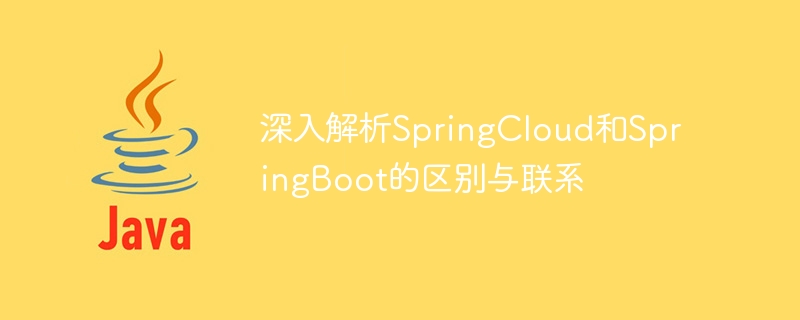 Java
Java
 javaTutorial
javaTutorial
 A deep dive into the differences and connections between SpringCloud and SpringBoot
A deep dive into the differences and connections between SpringCloud and SpringBoot
A deep dive into the differences and connections between SpringCloud and SpringBoot

In-depth analysis of the differences and connections between SpringCloud and SpringBoot requires specific code examples
Title: In-depth analysis of the differences and connections between SpringCloud and SpringBoot
Introduction :
In today's era of microservice architecture, SpringCloud and SpringBoot have become the preferred frameworks chosen by many enterprises and developers. However, for beginners, the differences and connections between Spring Cloud and Spring Boot can be relatively blurry. This article will deeply analyze the differences and connections between Spring Cloud and Spring Boot, and provide some specific code examples to help readers better understand these two frameworks.
1. SpringBoot
SpringBoot is a framework for building independent, executable Spring applications. It is designed to simplify the development of Spring applications and integration between various dependencies. SpringBoot provides automatic configuration and quick startup features, allowing developers to better focus on business logic rather than cumbersome configuration.
Code example:
@SpringBootApplication
public class HelloWorldApplication {
public static void main(String[] args) {
SpringApplication.run(HelloWorldApplication.class, args);
}
@RestController
public class HelloWorldController {
@GetMapping("/hello")
public String helloWorld() {
return "Hello, World!";
}
}
}The above example shows a simple SpringBoot application. The @SpringBootApplication annotation is used to identify the class as the entry point of the SpringBoot application. @RestController and @GetMapping annotations to define a simple REST interface.
2. SpringCloud
SpringCloud is a collection of development tools for distributed systems based on SpringBoot. It provides a set of tools and components for building distributed applications and services. SpringCloud is committed to solving various challenges in microservice architecture, such as service discovery, load balancing, service fault tolerance, configuration management, etc.
Code example:
@SpringBootApplication
@EnableDiscoveryClient
@RestController
public class HelloWorldApplication {
public static void main(String[] args) {
SpringApplication.run(HelloWorldApplication.class, args);
}
@GetMapping("/hello")
public String helloWorld() {
RestTemplate restTemplate = new RestTemplate();
return restTemplate.getForObject("http://localhost:8080/hello", String.class);
}
}The above example shows a Spring Cloud-based service consumer. With the support of the @EnableDiscoveryClient annotation, the provider can be accessed through service discovery Serve. Initiate HTTP requests through RestTemplate.
3. The relationship between SpringCloud and SpringBoot
Although SpringCloud and SpringBoot are two independent frameworks, they are closely related:
- SpringBoot is the foundation of SpringCloud, SpringCloud It is further expanded and integrated on the basis of SpringBoot. SpringBoot simplifies the development of Spring applications, while SpringCloud provides solutions for various distributed systems.
- SpringBoot provides automatic configuration and quick startup features, making SpringCloud more convenient to integrate and deploy.
- The versions of SpringBoot and SpringCloud are very compatible and can be easily upgraded.
4. Conclusions and Suggestions
SpringBoot and SpringCloud are ideal choices for developing microservice architecture. Their differences and connections are as follows:
- SpringBoot is a tool for A framework for building standalone, executable Spring applications, designed to simplify the development of Spring applications and the integration between various dependencies.
- SpringCloud is a collection of development tools for distributed systems based on SpringBoot, dedicated to solving various challenges in microservice architecture.
For beginners, you can start with SpringBoot and gradually understand and master the various components and features of SpringCloud. At the same time, it is recommended to read Spring official documents and related books, and participate in training and practice to better master these two frameworks.
In short, SpringBoot and SpringCloud provide developers with solutions to quickly build and deploy distributed systems, and more and more enterprises and developers choose them as the basis for application development. Through in-depth understanding and practice, readers will be able to better cope with the challenges of microservice architecture and bring more efficient and reliable distributed applications to enterprises.
The above is the detailed content of A deep dive into the differences and connections between SpringCloud and SpringBoot. For more information, please follow other related articles on the PHP Chinese website!

Hot AI Tools

Undresser.AI Undress
AI-powered app for creating realistic nude photos

AI Clothes Remover
Online AI tool for removing clothes from photos.

Undress AI Tool
Undress images for free

Clothoff.io
AI clothes remover

AI Hentai Generator
Generate AI Hentai for free.

Hot Article

Hot Tools

Notepad++7.3.1
Easy-to-use and free code editor

SublimeText3 Chinese version
Chinese version, very easy to use

Zend Studio 13.0.1
Powerful PHP integrated development environment

Dreamweaver CS6
Visual web development tools

SublimeText3 Mac version
God-level code editing software (SublimeText3)

Hot Topics
 1386
1386
 52
52

